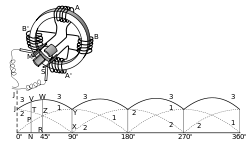


The Hawkins Electrical Guide was a technical engineering book written by Nehemiah Hawkins, first published in 1914, intended to explain the highly complex principles of the new technology of electricity in a way that could be understood by the common man. The book is notable for the extremely high number of detailed illustrations it contains, and the small softbound size of the volumes.
Contents
- Free media access on the Internet
- Google Books Volume Links
- Illustrations from Volume 1
- Chapter 14: The Dynamo: Current Commutation
- Chapter 15: Classes of Dynamo
- Chapter 16: Field Magnets
- Chapter 17: The Armature
- Chapter 19: Theory of the Armature
- Chapter 20: Commutation and the Commutator
- Illustrations from Volume 2
- Chapter 35: Operation of Motors
- Illustrations from Volume 4
- Chapter 46: Alternating Currents
- Illustrations from Volume 6
- Chapter 68: Wave Form Measurement
- Illustrations from Volume 7
- Chapter 66, Power Stations
- Notes
- References
The book was published by Theodore Audel & Company, with Theodore Audel being a pseudonym for Hawkins, who was publishing his own work. The majority of the illustrative content became the basis of decades of follow-up books published under the Audels brand name. The illustrative content of these books can still be found in Audels books sold new today.
Because the Hawkins Electrical Guide was printed in the United States prior to 1923, the content of the books has passed into the public domain.






























